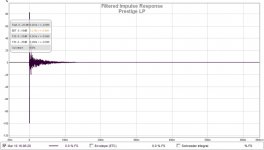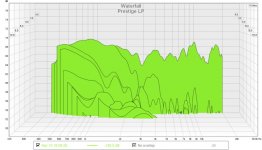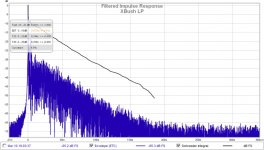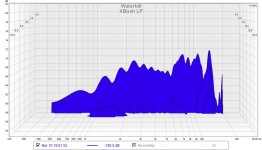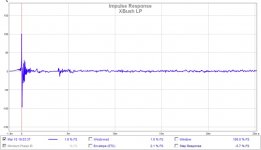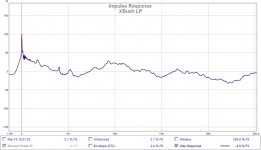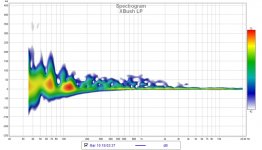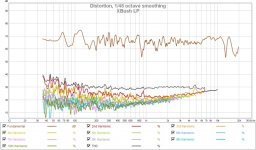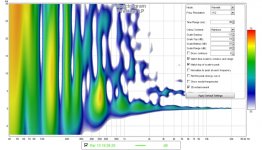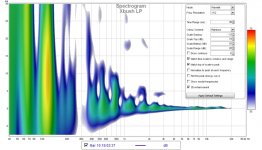Your room is doing pretty good, could you show the Filtered IR tab? down to -60 dB over a 500 ms window?
Really great work! But you HAVE to get rid of those buglehead screws! Use something with a flat contact surface, less damage to the frame, and less potential for material to displace around the screw head leading to a less-than-perfect contact point. When mounting from the rear, you can use washers, too.
Shall I switch over to the Xbush now? Or is there more measurements I need to do with the prestige?
Maybe an early waterfall plot... but you've got the measurements already.
APL_TDA would take more work, to install... but it does give a good picture of what's happening...
APL_TDA would take more work, to install... but it does give a good picture of what's happening...
Fun stuff! Apart from that strong reflection at 5 ms this is a pretty clean in room result. Are both sides of the room performing as clean? It will be fun to compare and analyze.
We won't get every answer, but we can get some clues.
Hope you saved the data, that spectrogram/wavelet plot is showing till 500 ms. I'd like to see the early wave front, like 30 ms.
We won't get every answer, but we can get some clues.
Hope you saved the data, that spectrogram/wavelet plot is showing till 500 ms. I'd like to see the early wave front, like 30 ms.
Last edited:
2 things that stand out immediately.
The early reflection at ~4/5 ms:
Prestige:
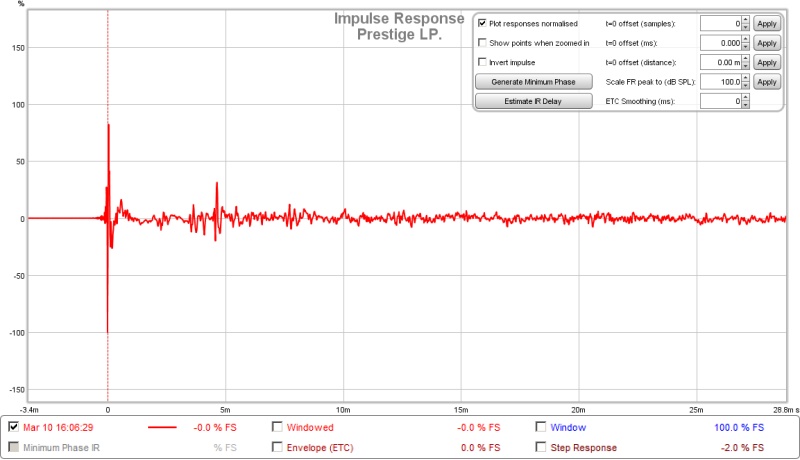
XBush:
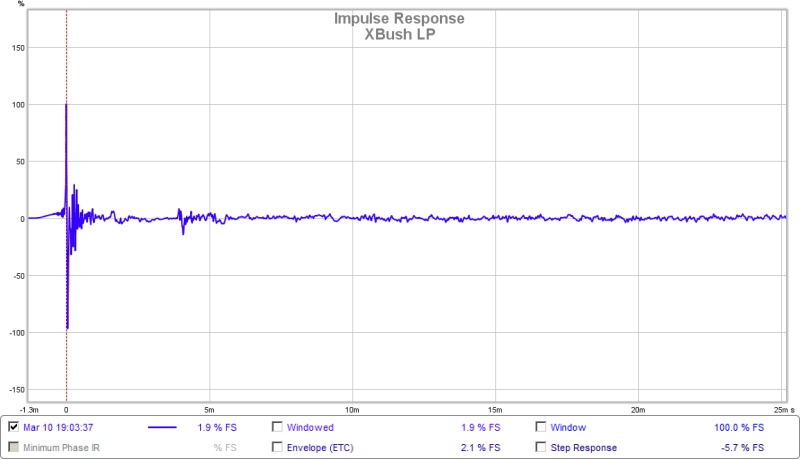
Seen even better in the Filtered IR (except for that pesky options dialog):
Prestige:
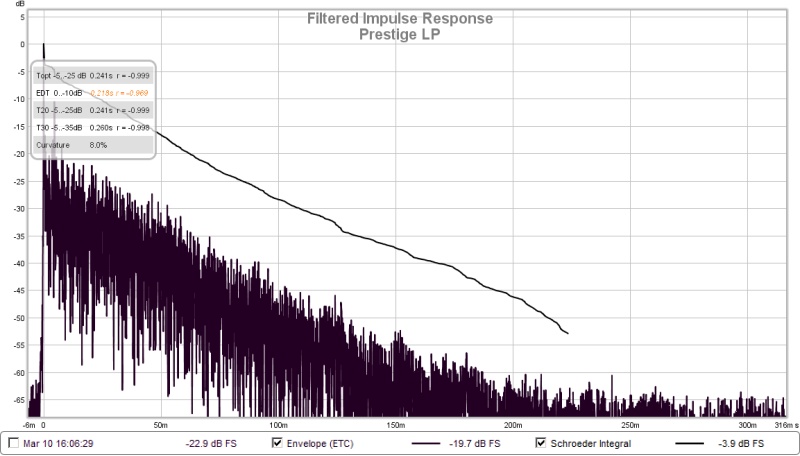
XBush:
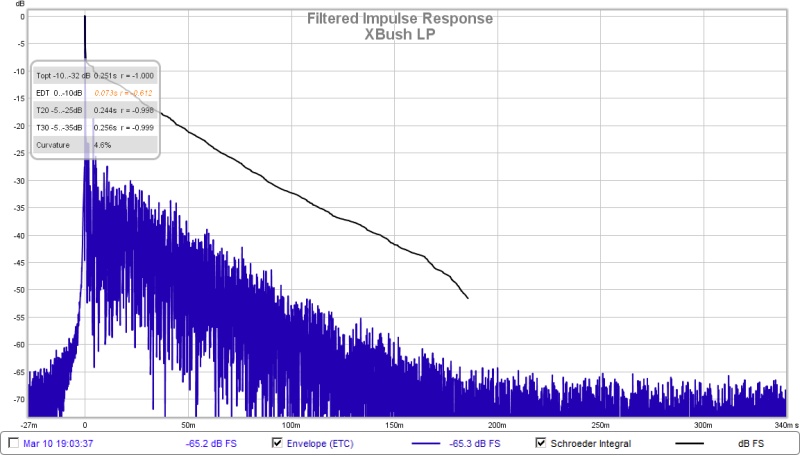
The reflection peak at ~4ms is down by almost 9 dB! Making it nearly below the -20 dB mark. I love how that horn keeps the early reflections down. So you ARE listening to less early reflections, and not by a small margin. You should overlay those two to compare...
The second is the timing in the wavelet. It follows an almost straight line with the XBush. Less drop outs in that plot but I'd like to see the early 30 ms in the wavelet. Edit: seen it, both have room for improvement, that's obvious. The XBush shows a cleaner result where the horn guides the wave front. But both suffer from problems at 300 Hz, XBush more than the Prestige. That's a pretty huge hole. If I were you I'd play with the time range to see if you can figure out what's happening over time. Check FR and Phase at similar gating settings...
But what happened to the mid's output in the early waterfall plot of the XBush? it seems missing in action completely?
The early reflection at ~4/5 ms:
Prestige:

XBush:

Seen even better in the Filtered IR (except for that pesky options dialog):
Prestige:

XBush:

The reflection peak at ~4ms is down by almost 9 dB! Making it nearly below the -20 dB mark. I love how that horn keeps the early reflections down. So you ARE listening to less early reflections, and not by a small margin. You should overlay those two to compare...
The second is the timing in the wavelet. It follows an almost straight line with the XBush. Less drop outs in that plot but I'd like to see the early 30 ms in the wavelet. Edit: seen it, both have room for improvement, that's obvious. The XBush shows a cleaner result where the horn guides the wave front. But both suffer from problems at 300 Hz, XBush more than the Prestige. That's a pretty huge hole. If I were you I'd play with the time range to see if you can figure out what's happening over time. Check FR and Phase at similar gating settings...
But what happened to the mid's output in the early waterfall plot of the XBush? it seems missing in action completely?
Last edited:
Thanks wesayso -
So it looks like my listening impressions hold water! The CD of the horn from 500hz upwards really does reduce the early reflections and allow that window into the recording.
My study is a terrible place right now for measurements and listening - I suspect the 300hz dropout is caused by the desk in between the speakers.
So there is little point me trying to optimize things too much, as I only just dragged one Xbush in here, perched it onto a stool and quickly did the measurement!
When they have a permanent home in my 'man cave listening room' I will look at solving issues as they arise.
But as I have said all along, even in this terrible, reflection ridden room with sub-optimal placement, the Xbush shines.
So it looks like my listening impressions hold water! The CD of the horn from 500hz upwards really does reduce the early reflections and allow that window into the recording.
My study is a terrible place right now for measurements and listening - I suspect the 300hz dropout is caused by the desk in between the speakers.
So there is little point me trying to optimize things too much, as I only just dragged one Xbush in here, perched it onto a stool and quickly did the measurement!
When they have a permanent home in my 'man cave listening room' I will look at solving issues as they arise.
But as I have said all along, even in this terrible, reflection ridden room with sub-optimal placement, the Xbush shines.
I don't think the room is that bad, I only see one real big reflection there (the desk?) the rest is minor, the gradual decline in the ETC is quite quick, with a bit of help these speakers will knock your socks off! Check your mail 🙂.
Hello,
the only proper thing about the Synergy is the conical horn, which gives an even beamwidth for the tweeter. But you use in one or two dimensions exponentials horns which beam unevenly, say radiate the trebles very narrowly. In the Synergy the midrange is neither directly radiating nor a proper horn, and i miss the point. A convex two-dimensional array of Synergys also beams lower frequencies, because of the convex array, hence it may work for PA, and i still miss the point. Thou use the Synergy blueprint for a home speaker, right? Why? I miss the point.
Uli
the only proper thing about the Synergy is the conical horn, which gives an even beamwidth for the tweeter. But you use in one or two dimensions exponentials horns which beam unevenly, say radiate the trebles very narrowly. In the Synergy the midrange is neither directly radiating nor a proper horn, and i miss the point. A convex two-dimensional array of Synergys also beams lower frequencies, because of the convex array, hence it may work for PA, and i still miss the point. Thou use the Synergy blueprint for a home speaker, right? Why? I miss the point.
Uli
I suspect the 300hz dropout is caused by the desk in between the speakers.
Maybe, but from my experience this kind of reflective surface (of this size) are usually more objectionable higher (800/3000hz).
I would suspect more something like a rear wave radiation issue.
Bushmeister next time (if there is one) maybe you could try to move speakers more inside the room (far from rear wall) or the inverse (closer to rear wall). If the valley (in fr, the 300hz 'hole' in wavelet) move you know from where the issue come (one of the reason flush speakers are great).
Overall this is quite nice: the 9db attenuation of ER means it will be easy to treat them using some sidewall absorbers.
The tradeoff for small sweetspot (versus a 90° horn) is gained in accuracy of reproduced message and easier acoustic treatment. Nice to be selfish sometimes! 🙂
Last edited:
Maybe, but from my experience this kind of reflective surface (of this size) are usually more objectionable higher (800/3000hz).
I would suspect more something like a rear wave radiation issue.
Bushmeister next time (if there is one) maybe you could try to move speakers more inside the room (far from rear wall) or the inverse (closer to rear wall). If the valley (in fr, the 300hz 'hole' in wavelet) move you know from where the issue come (one of the reason flush speakers are great).
Overall this is quite nice: the 9db attenuation of ER means it will be easy to treat them using some sidewall absorbers.
The tradeoff for small sweetspot (versus a 90° horn) is gained in accuracy of reproduced message and easier acoustic treatment. Nice to be selfish sometimes! 🙂
I bet you are right - they are right against the wall, - although I would expect a lower cancellation dip as the front of the horn is probably about 60cm from the wall - perhaps a combination of desk/wall....
Anyway - I bet it is positional.
You are absolutely right about the 60 degree horn choice - I have many 'social' speakers, these are just for me!
I don't think the room is that bad, I only see one real big reflection there (the desk?) the rest is minor, the gradual decline in the ETC is quite quick, with a bit of help these speakers will knock your socks off! Check your mail 🙂.
Wow! Thanks so much wesayso - incredible predicted measurements with your convolution magic!
I just need to get software savvy, then I can try it out - perhaps this weekend.
JRiver has a 30 day trail 😀... I bet you will start to miss it after those 30 days. I know I did! Who needs a miniDSP when you have a maxi at your disposal (lol).
perhaps a combination of desk/wall....
Oh yes, combination can happen sometimes: they are difficult to determine at first, but once you change one by one variable you could identify them.
Ronald you already done some FIR for correcting phase behavior?! 🙂
- Home
- Loudspeakers
- Multi-Way
- A Bookshelf Multi-Way Point-Source Horn
